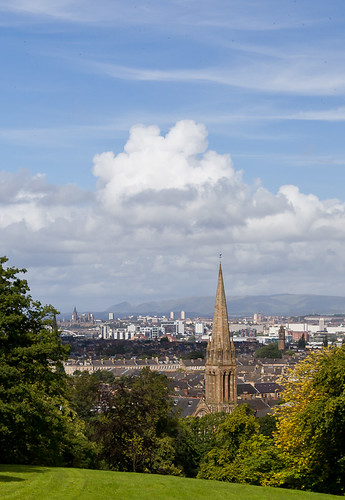 |
| View over Glasgow from Queen's Park |
The route plan was largely put together by Mike. His long walks through various Glasgow neighbourhoods gave him good insight into how to get from one park to the next without going through too much traffic. Also, Mike mastered the Clyde Tunnel -- the key to quickly getting from one side of Glasgow to the other. About 1km long, it crosses under the River Clyde quite a bit downstream from the bridges. Cyclists and pedestrians are separated from cars and have their own tunnels, but it can be a devil to find the entrance if you are newcomers to the Glasgow cycling scene.
Our route was circular, starting and ending in our Hillhead neighbourhood. Hillhead is very close to the University of Glasgow, so we travelled west on some of the bike routes through the area to our first stop: Victoria Park and its amazing Fossil Grove. The park was named for Queen Victoria's Golden Jubilee and has some beautiful formal gardens and ponds. But, the thing that drew us to the park was a chance to see the fossilized remains of a forest that grew here 330 million years ago. At that time the terrain Glasgow sits on was located someplace close to the equator and huge forests of giant clubmoss ruled the land. The remains of this forest were found in 1887 when the park was being created. Today you can see the huge fossilized stumps in situ from a viewing platform in the park. Amazing to look at something that old in such detail.
From Victoria we headed for the Clyde Tunnel and nipped by Elder Park in Govan. We were not headed to a park, per se, but to get a view of Glasgow's latest triumph - the Riverside Museum. We were there on June 21st, opening day, and have visited a few times since. It holds the collection of the old Museum of Transportation, but in a new, purpose-built hall. I think the best view of the building itself is from across the Clyde at the Govan public wharf -- and that is where we pulled up.
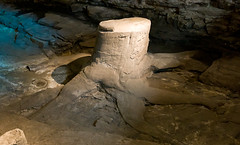 |
| 330 million year old tree |
Next on the agenda was Bellahouston Park, but we had to cross the M8 motorway to get there. Mike researched the route, and, using the GoBike Glasgow bike map and a bit of navigational expertise got us across on a walkway.
I think Bellahouston is my favourite Glasgow park. It is big (159 acres) and has outstanding views from its highest point. But, the thing I love the most is the walled garden. It is like stepping into a calm oasis of colour and light. The walls cut both wind and sound -- it is a place where you could imagine spending a restful hour reading or sketching.
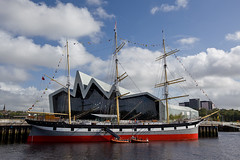 |
| Riverside Museum and the Glenlee tall ship |
I wish I could have been in Glasgow in 1938 to see the Empire Exhibition which was held in Bellahouston. The pictures from the event paint a scene of modernity and culture fitting into the park setting. 200 pavilions and palaces from all across the British Empire -- in hindsight it must have seemed like a happy summer holiday before the cold winter winds of the Second World War blew across Scotland and the rest of the world.
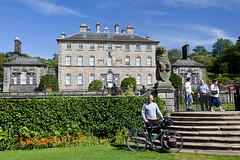 |
| Mike in front of Pollock House |
From Pollock Park it was on to the glass conservatories and city views of Queen's Park. We rode through some elegant Shawlands tenements and had a steep uphill pull to the entrance gates. This park has a reptile house and an aviary as well as a plant conservatory. But, the thing we were most interested in at Queen's Park was the view out over the city. We could see right back to our Glasgow University neighbourhood, and beyond to the Campsie Fells and Dumgoyne hill, above the city.
We then cut down to Linn Park and up to King's Park to visit the sundial. From here we rode north east through Rutherglen to cross the Clyde on the Dalmarnock Road bridge. Next up was Tollcross Park and another glasshouse conservatory. Tollcross has many formal gardens and gazebos, and lots of paths for bikes and pedestrians.
Another port of call on this route was tiny Molendinar Park (at least we think it is called Molendinar) on Craighead Ave in the Royston neighbourhood. This park is only one of two places where you can see the Molendinar Burn. This is the original "Dear Green Place" -- the creek on which Glasgow was founded centuries ago. Indeed, it runs directly to the east of the Cathedral, although today it is covered over for almost its entire length. It can also be seen for a few metres down in the Cathedral precinct, close to the corner of Duke and John Knox St.
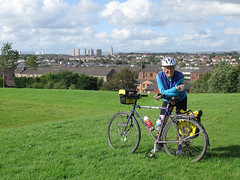 |
| Mary in Robroyston Park |
From here it was home via George's Square in the downtown and Hengler's Circus pub on Sauchiehall St. We barely made it through the downtown, dodging film crews and road blocks because the new Brad Pitt movie -- something to do with zombies -- was shooting in George's Square. And, of course, any place for a pint is always good for an hour's diversion. We sailed home in the early evening, traversing Kelvingrove, the last park on our route. This park, with broad terraced paths, flower gardens, play areas, and the famous Kelvingrove Museum, was our "home" park. We knew every path by heart, so it was an easy and comfortable ride back to the flat.
All in all, cycling the parks of Glasgow is a very enjoyable way to roll through a summer's day -- not only did the ride have a theme, but we got an up-close view of this diverse and fascinating city.
*As of Sept 7 Mike and I are back home in Victoria, but I still have a few more stories to tell about our time in Scotland, so there will be a few more posts on the blog.
The map of our Glasgow Parks route:
View A bike ride through Glasgow's Parks: Aug 20, 2011 in a larger map
More pictures of our Glasgow Parks ride.



